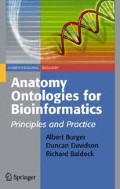Summary
The Edinburgh Mouse Atlas Project (EMAP) Anatomy Ontology is a hierarchically organised list of histologically distinguishable tissues visible at each Theiler stage of development. The ontology is held in the EMAP Anatomy Database freely available from http://genex.hgu.mrc.ac.uk/. The ontology was developed to be both a standard reference for describing normal and mutant tissue anatomy, and a mechanism to allow textual descriptions of gene expression patterns submitted to the Edinburgh Mouse Atlas of Gene Expression (EMAGE) database. It has also been adopted by the Mouse Genome Informatics (MGI) Group for use in their GXD gene expression database. The ontology uses ‘part-of’ relationships and is based primarily on anatomical structure rather than function. Presentation of the ontology as a hierarchy (tree) for each developmental stage displays the structural relationships between the anatomical entities within each stage as well as during the process of development. This part-of hierarchy defines how the ontology is used in the annotation of gene expression patterns, specifically how logic relating to annotated regions is propagated up and down the tree.
The anatomy ontology is an integral part of the EMAP Mouse Atlas. The Atlas also includes three-dimensional models of mouse embryos, one or more for each developmental stage. Selected anatomical terms are represented by domains in the corresponding model. These domains link anatomical concepts with space in the embryo and thus give a structural definition to the corresponding terms in the ontology. Current developments include the provision of additional parent anatomical terms that can be envisioned as standing above the basic tree to provide alternative groupings of the underlying tissues. The ontology is also being expanded to include tissue derivation relationships. The anatomy hierarchy for each stage represents instances of stage-independent concepts. Future versions of the ontology will provide this stage-independent view of the entire mouse anatomy.
Access this chapter
Tax calculation will be finalised at checkout
Purchases are for personal use only
Preview
Unable to display preview. Download preview PDF.
References
Alvarez-Bolado, G. and Swanson, L. W. (1995). Structure of the Embryonic Rat Brain.Elsvier Science Publishers B. V., Amsterdam.
Baldock, R., Bard, J., Kaufman, M., and Davidson, D. (1992). A real mouse for your computer. BioEssays, 14:501–502.
Bard, J. B. L., Baldock, R. A., Kaufman, M., and Davidson, D. (1997). Graphical geneexpressiondatabase for mouse development. European Journal of Morphology, 35(1):32–34.
Burger, A., Davidson, D., and Baldock, R. (2004a). Formalization of mouse embryoanatomy. Bioinformatics, 20:259–267.
Burger, A., Davidson, D., Yang, Y., and Baldock, R. (2004b). Integrating multiple partonomichierarchies in anatomy ontologies. BMC Bioinformatics, 5:184.
Christiansen, J. Emage: database structure and rules for the annotation and querying language.
Christiansen, J. H., Yang, Y., Venkataraman, S., Richardson, L., Stevenson, P., Burton, N.,Baldock, R. A., and Davidson, D. R. (2006). Emage: a spatial database of gene expressionpatterns during mouse embryo development. Nucl. Acids Res., 34:D637.
Dadzie, A.-S. and Burger, A. (2005). Providing visualisation support for the analysis ofanatomy ontology data. BMC Bioinformatics, 6(1):74.
Davidson, D. and Baldock, R. (2001). Bioinformatics beyond sequence: Mapping genefunction in the embryo. Nature Reviews Genetics, 2:409–418.
Downes, K. and Davies, T. (1993). Staging of gastrulating mouse embryos by morphologicallandmarks in the dissecting microscope. Development, 118:1255–1266.
Gerstl, P. and Pribbenow, S. (1995). Midwinters, end games, and body parts: a classificationof part-whole relations. Int. J. Hum.-Comput. Stud., 43(5-6):865–889.
Kaufman, M. (1994). The Atlas of Mouse Development. Academic Press., London.
Little, M., Brennan, J., Georgas, K., Davies, J., Davidson, D., Baldock, R., Beverdam,A., Bertram, J., Capel, B., Chiu, H., Clements, D., Cullen-McEwen, L., Fleming, J., Gilbert,T., Houghton, D., Kaufman, M., Kleymenova, E., Koopman, P., Lewis, A., McMahon, A., Mendelsohn, C., Mitchell, E., Rumballe, B., Sweeney, D., Valerius, M., Yamada, G., Yang,Y., and Yu, J. (2007). A high-resolution anatomical ontology of the developing murinegenitourinary tract. Gene Expr Patterns.
Paxinos, G. and Franklin, K. B. J. (2001). The Mouse Brain in Stereotaxic Coordinates.Academic Press, San Diego, 2nd edition.
Puelles, L. and Rubenstein, J. L. R. (2003). Forebrain gene expression domains and theevolving prosomeric model. Trends Neurosci, 26(9):469–476.
Ringwald, M., Baldock, R., Bard, J., Kaufman, M., Eppig, J., Richardson, J., Nadeau, J.,and Davidson, D. (1994). A database for mouse development. Science, 265:2033–2034.
Smith, B., Ceusters, W., and Jacob Köhler, B. K., Kumar, A., Lomax, J., Mungall, C.,Neuhaus, F., Rector, A. L., and Rosse, C. (2005). Relations in biomedical ontologies. Genome Biology, 6(R46).
Swanson, L. (1998). Brain Maps: Structure of the Rat Brain 2nd Edition. Elsevier SciencePublishers B.V., Amsterdam.
Theiler, K. (1989). The House Mouse. Springer-Verlag, New York.
Editor information
Rights and permissions
Copyright information
© 2008 Albert Burger, Duncan Davidson, Richard Baldock
About this chapter
Cite this chapter
Baldock, R., Davidson, D. (2008). The Edinburgh Mouse Atlas. In: Burger, A., Davidson, D., Baldock, R. (eds) Anatomy Ontologies for Bioinformatics. Computational Biology, vol 6. Springer, London. https://doi.org/10.1007/978-1-84628-885-2_12
Download citation
DOI: https://doi.org/10.1007/978-1-84628-885-2_12
Publisher Name: Springer, London
Print ISBN: 978-1-84628-884-5
Online ISBN: 978-1-84628-885-2
eBook Packages: Computer ScienceComputer Science (R0)

